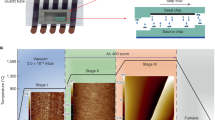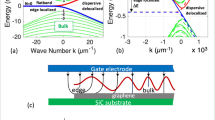Abstract
High-quality epitaxial graphene on silicon carbide (SiC) is today available in wafer size1,2. Similar to exfoliated graphene3,4, its charge carriers are governed by the Dirac–Weyl Hamiltonian5,6,7 and it shows excellent mobilities7,8. For many experiments with graphene, in particular for surface science, a bottom gate is desirable9,10,11,12,13. Commonly, exfoliated graphene flakes are placed on an oxidized silicon wafer that readily provides a bottom gate3,4,11. However, this cannot be applied to epitaxial graphene as the SiC provides the source material out of which graphene grows. Here, we present a reliable scheme for the fabrication of bottom-gated epitaxial graphene devices, which is based on nitrogen (N) implantation into a SiC wafer and subsequent graphene growth. We demonstrate working devices in a broad temperature range from 6 to 300 K. Two gating regimes can be addressed, which opens a wide engineering space for tailored devices by controlling the doping of the gate structure.
This is a preview of subscription content, access via your institution
Access options
Subscribe to this journal
Receive 12 print issues and online access
$259.00 per year
only $21.58 per issue
Buy this article
- Purchase on Springer Link
- Instant access to full article PDF
Prices may be subject to local taxes which are calculated during checkout





Similar content being viewed by others
References
Emtsev, K. V. et al. Towards wafer-size graphene layers by atmospheric pressure graphitization of silicon carbide. Nature Mater. 8, 203–207 (2009).
Lin, Y. M. et al. 100-GHz transistors from wafer-scale epitaxial graphene. Science 327, 662 (2010).
Novoselov, K. S. et al. Two-dimensional gas of massless Dirac fermions in graphene. Nature 438, 197–200 (2005).
Zhang, Y. et al. Experimental observation of the quantum Hall effect and Berry’s phase in graphene. Nature 438, 201–204 (2005).
Jobst, J. et al. Quantum oscillations and quantum Hall effect in epitaxial graphene. Phys. Rev. B 81, 195434 (2010).
Tzalenchuk, A. et al. Towards a quantum resistance standard based on epitaxial graphene. Nature Nanotech. 5, 186–189 (2010).
Tanabe, S., Sekine, Y., Kageshima, H., Nagase, M. & Hibino, H. Half-integer quantum Hall effect in gate-controlled epitaxial graphene devices. Appl. Phys. Exp. 3, 075102 (2010).
Berger, C. et al. Electronic confinement and coherence in patterned epitaxial graphene. Science 312, 1191–1196 (2006).
Schedin, F. et al. Detection of individual gas molecules adsorbed on graphene. Nature Mater. 4, 652–655 (2007).
Martin, J. et al. Observation of electron–hole puddles in graphene using a scanning single-electron transistor. Nature Phys. 4, 144–148 (2008).
Chen, J-H. et al. Charged-impurity scattering in graphene. Nature Phys. 4, 377–381 (2008).
Zhang, Y., Brar, V. W., Gitit, C., Zettl, A. & Crommie, M. F. Origin of spatial charge inhomogeneity in graphene. Nature Phys. 5, 722–726 (2009).
Bostwick, A. et al. Observation of plasmarons in quasi-freestanding doped graphene. Science 328, 999–1002 (2010).
Ziegler, J. F., Biersack, J. P. & Littmark, U. The Stopping and Range of Ions in Solids (Pergamon, 1985).
Dalibor, T. et al. Deep defect centres in silicon carbide monitored with deep level transient spectroscopy. Phys. Status Solidi A 162, 199–225 (1997).
Reshanov, S. A. et al. Effect of intermediate graphite layer on the electronic properties or metal/SiC contacts. Phys. Status Solidi B 245, 1369–1377 (2008).
Mattausch, A. & Pankratov, O. Ab Initio study of graphene on SiC. Phys. Rev. Lett. 99, 076802 (2007).
Riedl, C. et al. Quasi-free-standing epitaxial graphene on SiC obtained by hydrogen intercalation. Phys. Rev. Lett. 103, 246804 (2009).
Speck, et al. Quasi-Freestanding graphene on SiC(0001). Mater. Sci. Forum 645–648, 629–632 (2010).
Reshanov, S. A. et al. Effect of Schottky barrier height on the detection of midgap levels in 4H–SiC by deep level transient spectroscopy. Mater. Sci. Forum 600–603, 417–420 (2009).
Acknowledgements
We gratefully acknowledge support by the DFG under contracts WE 4542-5-1 and Se 1087/5-1, and within the Cluster of Excellence ‘Engineering of Advanced Materials’ (www.eam.uni-erlangen.de) at the Friedrich-Alexander-Universität Erlangen-Nürnberg. We acknowledge the use of the 16 T magnet provided by P. Müller.
Author information
Authors and Affiliations
Contributions
D.W. and J.J. carried out the experiment and data analysis. F.S. and T.S. developed the hydrogen intercalation procedure and assisted with sample preparation. D.W., J.J., M.K. and H.B.W. developed the model and wrote the manuscript. T.S. and H.B.W. conceived the experiment.
Corresponding author
Ethics declarations
Competing interests
The authors declare no competing financial interests.
Rights and permissions
About this article
Cite this article
Waldmann, D., Jobst, J., Speck, F. et al. Bottom-gated epitaxial graphene. Nature Mater 10, 357–360 (2011). https://doi.org/10.1038/nmat2988
Received:
Accepted:
Published:
Issue Date:
DOI: https://doi.org/10.1038/nmat2988
This article is cited by
-
Magnetic Oscillations in a Model of Graphene
Communications in Mathematical Physics (2019)
-
Fast growth of inch-sized single-crystalline graphene from a controlled single nucleus on Cu–Ni alloys
Nature Materials (2016)
-
Visualisation of edge effects in side-gated graphene nanodevices
Scientific Reports (2014)
-
Practical and Fundamental Impact of Epitaxial Graphene on Quantum Metrology
MAPAN (2013)
-
Carbon nanomaterials field-effect-transistor-based biosensors
NPG Asia Materials (2012)



